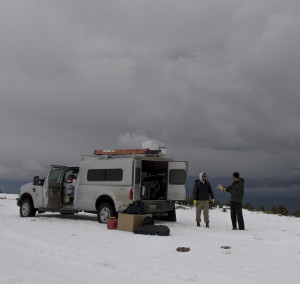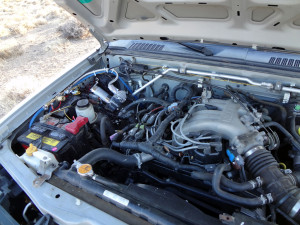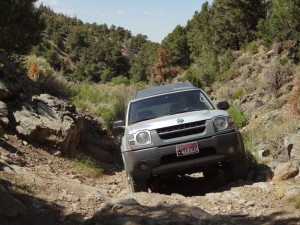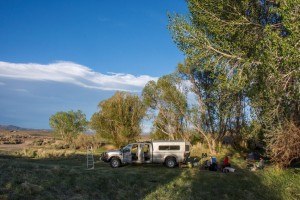
Unless you do your field science right outside your office door, chances are that you use some sort of mechanical conveyance to get to your research sites. Most interesting places for research aren’t exactly next to a paved road – but if that’s true for you, you have either been blessed logistically or you need to get out more. A good portion of us, however, will require a four-wheel-drive of some kind to carry us and our gear into parts unknown. Let’s face it: until hover conversions are prevalent and we’ve figured out how to leverage unicorn byproducts for fuel, today’s field scientists will be frequently faced with piloting 4×4’s with internal combustion engines down challenging trails.
The logistics of travel via automobile have become so streamlined, commonplace, and uniform that it is easy to take them for granted. Just a few hours of sitting in a seat can bring us across a desert, up a mountain, or into the deep forest. The amount of ground you can cover, the number of field sites you can visit, and the volume of data that you can collect goes up exponentially if you make the leap from foot or horse travel to auto for everything except that last mile. Sure, you have to hop out of the air conditioning to fill up the tank and get a coffee, but unless you are going to Antarctica or similar, attention to detail for field science outings is not the way it used to be (a fact easily forgotten until one of those critical thousands of moving parts and electrical systems in your rig breaks or malfunctions).
Proper care and feeding of your rig is as crucial to your field success as remembering to pack your French press. In the geosciences community, there is no shortage of auto-related tales involving unexpected overnights, longs walks to civilization, and expensive, failed trips. If a 4×4 is treated as a lifetime tool rather than a borrowed or disposable item, it is much less likely to let you down at the critical moment. For those of you that share a pool of field vehicles, take special note: it only takes one irresponsible or inexperienced clown to ruin research trips for everyone. Don’t be that person.
“Proper care and feeding of your rig is as crucial to your field success as remembering to pack your French press.”
1. Know your rig. If everything under the hood is a black box in your mind, you should think twice about venturing too far off the pavement.

You won’t be able to properly address even the most minor of issues.
- Be familiar with the systems of the vehicle, especially the high/low ranges and traction-control. Understand how they work, how they are actuated, and why/when to use them.
- Be familiar with the maintenance needs and schedule – if your involvement with the condition of the vehicle ends with driving it to your nearest “fast lube”, you won’t be able to diagnose issues in the field. Heavy field use dramatically accelerates the maintenance schedule. Neglect this, and the vehicle life expectancy drops accordingly.
- Tires are the interface between you and the earth’s surface. Become familiar with correct tire pressure for your vehicle weight and how this affects safety, economy, and performance on and off the pavement. Ignore tire pressure at your own risk, I check before every trip. If you manage your own field rig, purchase tires that match the job. Even better, manage the pressure according to the job.
2. When you leave the pavement, change your mindset.
- When you leave the pavement, the willingness of tow trucks to come aid you drops accordingly. The need to be aware of surface conditions, potential problems with the vehicle, and alternatives if you are stranded becomes acute.
- The farther you get from civilization, the longer of a walk back it becomes if your vehicle lets you down. Behave accordingly.

3. Drive like Grandma.
- Unlike serious auto-racing, trying to force a 4×4 to do something is asking for trouble. Applying power when you don’t understand exactly what is causing a problem with traction is the surest way to break something in the drivetrain. 90% of traction problems on dirt trails are due to issues such as incorrect tire positioning, weight distribution, or incorrect tire selection. Trying to “power out” in these cases is more likely to cause catastrophic breakage.
- Beating a truck down a dirt road at high speed prematurely wears everything related to suspension. It also rattles everything in the vehicle loose, including electrical sensors and wires. Drive at a speed that matches your tire pressure settings and suspension comfort. If it’s uncomfortable for your passengers, it’s hard on the truck.
- Easing on and off the throttle is better for your engine, transmission, tires, and the rest of the drivetrain. If you want the vehicle to last, keep this in mind.
- Most 4×4 vehicles are quite heavy compared to cars. This means that momentum and stopping times are quite different. It also means that recovery from being “stuck” or worse is much more difficult. Again, behave accordingly.

4. Increase your skills.
- If you are one of the many people in field science who did not grow up driving on dirt trails, don’t let it stop you. Instead, learn more about it and pay attention to details. 4×4 operation is extremely intuitive, meaning that anyone with an eye (and ear) for detail can become highly skilled simply through practice and learning from each opportunity.
- Find someone you know is a 4×4 guru and get them to drive for you. If they explain how and why they are making various decisions, your learning curve is easier to surmount. If there are classes on 4×4 operation, vehicle maintenance, and off-road recovery in your area take advantage of them.
- Recognize that a good driver is worth much more than the latest technology – it doesn’t matter how fancy of a rig you have, if you don’t have the experience to use it properly you will still break it and/or strand yourself and your crew.
5. Know when to stop.
- Those of us with entertaining 4×4 stories can usually point to the original problem as being a decision: we decided to continue, rather than hold off. If you don’t see exactly how to proceed or know from experience exactly how your vehicle will behave in a particular situation, don’t try it.
Bottom line, most graduate students and field personnel that I have interacted with over the years approach their field rig as a disposable item. They drive it improperly with little notion of how the machine actually works. When the machine breaks down, it is always the machine’s fault. In fact, most mechanical breakdowns in autos are due to minor component failures that are compounded by continued use and failure to recognize the problem. The only reason for this is the operator’s ignorance of the system.
Apparently, field safety is a science now. In private industry, people are not given control of machines unless they have received training and/or demonstrated proficiency. In the academic science realm, there are plenty of loopholes and off-pavement operation of 4×4’s is one of them. Very typically students are sent to the field regardless of their actual driving/4×4 capabilities, mostly because the P.I.’s themselves are fairly ignorant of field transport best practices. “Learning by doing” under these circumstances can become very expensive or worse if things go south.

In the end, field transportation of people and equipment is not trivial, and should be treated as a luxury. It needs to be approached with care, common sense, and respect. Proper operation of 4×4’s can greatly enhance scientific data collection if used appropriately and safely. Treat your field truck with the same care you give to that high-dollar laboratory equipment and it will reciprocate the effort.
Do you have a fun or cautionary tale about field vehicles? Post it as a comment!
Until next time……don’t drive like my brother!
